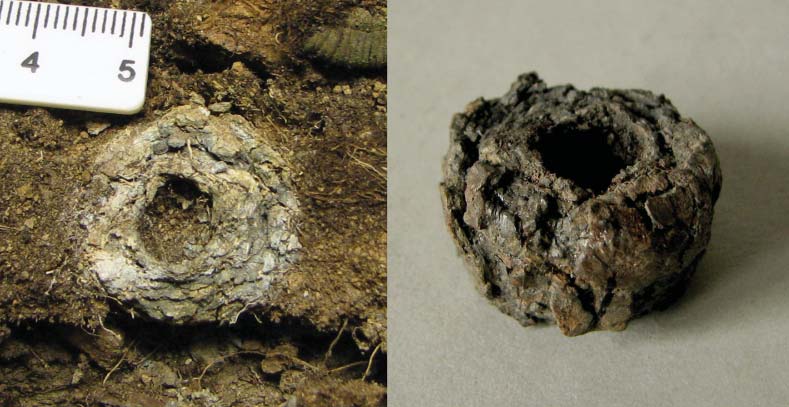ARCHAEOLOGICAL LEAD CORROSION AND RESTORATION METHODOLOGY
DOI:
https://doi.org/10.24852/2587-6112.2021.6.223.234Keywords:
archaeological lead, conservation of archaeological finds, metal restoration methodologyAbstract
The selection of a method for the restoration treatment of archaeological objects directly depends on their condition. The selection of an adequate method for the restoration of lead objects is complicated by the need to choose between the preservation of the material substance of the object and its historical appearance. All currently known methods of stabilizing active corrosion on archaeological lead inevitably result in the loss of all mineral crusts and oxide films, which negatively affects the perception of the objects and distorts their historical appearance. The classification of the preservation states of lead objects and a review of the restoration methods proposed in the paper are designed to aid restorers in the minimization of possible negative consequences when developing a restoration strategy.
References
Герасимова Н.Г., Панченко Н.А. Реставрация и консервация свинцовых печатей в Государственном Эрмитаже // Реликвия. Реставрация, консервация, музеи. 2017. № 34. С. 5-12.
Геттенс Р.Дж., Орган Р.М. Электролитическая и электрохимическая обработка минерализовав¬шегося металла (опрос) // Доклады иностранных специалистов, прочитанные на конференции комите¬та по лабораториям музеев и подкомитета по реставрации живописи международного совета музеев, состоявшейся в сентябре 1963 г. / Сообщения ВЦНИИЛКР, Приложение 3. Вып. 3. М.: ВЦНИИЛКР, 1968. 137 с.
Курганов Н.С., Горлов К.В. Цветные наслоения на поверхности средневековых товарных пломб: исследования в процессе реставрации // Stratum plus. 2017. № 6. С. 361-370.
Минжулин А.И. Введение в реставрацию металла. Учебно-методическое пособие. Киев: КВИУС, 1992, 100 с.
Очерки по методике технологического исследования, реставрации и консервации древних металли¬ческих изделий / ИГАИМК. Вып. 130. М.-Л.: ОГИЗ, 1935. 121 с.
Плендерлис Г.Дж. Консервация древностей и произведений искусства. Пер. с англ. И.А. Токма¬ковой, И.П. Мокрецовой и М.Н. Иванова, под общ ред. д.х.н. С.А. Зайцева / Сообщения ВЦНИИЛКР 10-11. Вып. 3. М.: ВЦНИИЛКР. 1964. 176 с.
Скотт А. Очистка и реставрация музейных экспонатов. Пер. с англ. В.А. Фроловой и В.Е. Фарма- ковской / ИГАИМК. Вып. 114. М.-Л.: ОГИЗ, 1935. 72 с.
Фармаковский М.Ф. Консервация и реставрация музейных коллекций. М.: Красный печатник, 1947. 144 с.
Шемаханская М.С. Металлы и вещи. История. Свойства. Разрушение. Реставрация. M: Индрик. 2015. 288 с.
Aslund A., Bergsten C.J., Chiavari C., Martini C., Niklasson A., Prandstraller D., Svensson J-E. Conser¬vation strategies against the corrosion of historical pipe organs // Metal 07: Interim Meeting of the ICOM-CC Metal WG Amsterdam, 17-21 September 2007. Book 5. Protection of metal artefacts / Amsterdam: Rijks- museum, 2007. P. 16-22.
Bellegem M., Wang Q., Fletcher P A scientific study and preliminary experiments for electrolytic reduc¬tion of corroded lead inlay on Japanese lacquer objects // Metal 2010, Proceedings of the Interim Meeting of the ICOM-CC Metal Working Group, Charleston, South Carolina, USA,11-15 October 2010 / Edited by Paul Mardikian, Claudia Chemello, Christopher Watters and Peter Hull / Clemson: Clemson University, 2011. P. 348-356.
Caley R. Coatings and incrustations on lead objects from Agora and the method used for their removal // Studies in Conservation. 1955. № 2. Р. 49-54.
Carradice I.A., Campbell S.A. The conservation of lead communion tokens by potentiostatic reduction // Studies in Conservation. 1994. № 39. Р. 100-106.
Cronyn J.M. The Elements of Archaeological Conservation. London: Routledge, 1990. 326 p.
Degrigny, C., and Le Gall, R. Conservation of ancient lead artefacts corroded in organic acid environ¬ments: electrolytic stabilization/consolidation // Studies in Conservation. 1999. №44. Р. 157-169.
Duncan S.J., Ganiaris H. Some sulfide corrosion products on copper alloys and lead alloys from London waterlogged sites // Recent Advances in the Conservation and Analysis of Artifacts: Jubilee Conservation Conference Papers / Edited by James Black / Michigan: Summer Schools Press, 1987. Р. 109-117.
Lane H. Some comparisons of lead conservation methods, including consolidative reduction // The Conser¬vation and Restoration of Metals / Scottish Society for Conservation and Restoration. Edinburgh, 1979, Р. 48-58.
Nosek E.M. The investigation and conservation of a lead paten from the eleventh century // Studies in Conservation 30, 1985, 19-22.
Organ, R.M. Use of ion-exchange resins in the treatment of lead objects. // Museums Journal. 1953. No 53. 49-52.
Organ, R.M. The current status of the treatment of corroded metal artifacts. // Corrosion and Metal Arte¬facts. Special publication 179 / Brown, B.F., Burnett, H.C., Chase, W.T., Goodway, M., Kruger, J., and Poubaix, M. (eds). Washington, D.C.: National Bureau of Standards, 1977, Р. 107-142.
Schotte B., Adriaens A. Treatment of corroded lead artifacts: an overview // Studies in conservation 2006. № 51. Р. 297-304.
Watson J. Conservation of lead and lead alloys using E.D.T.A. solutions // Lead and Tin: Studies in Conser¬vation and Technology / UKIC Occasional Paper № 3. London: United Kingdom Institute for Conservation, 1985. Р. 44-45.

Downloads
Published
How to Cite
Issue
Section
License
Copyright (c) 2021 Burshneva Svetlana G.

This work is licensed under a Creative Commons Attribution-NonCommercial 4.0 International License.







